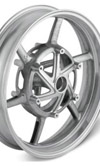Thermal deburring
 In racing we rely much more on machined components than our counterparts in the arena of series production engine design - we need to make parts quickly, we need the flexibility to make swift design changes and we want to take advantage of the improved mechanical and fatigue properties that high quality wrought materials offer us compared to castings etc. Whilst we all want to save money, especially in these straitened times of financial recession, we have less financial constraints than companies who have to produce hundreds of thousands of the same component. To them any financial saving is worth a serious amount of money, and part of the skill of an engine component designer in mainstream production automotive work is to be able to design a component to be made by a cheap manufacturing route. Certainly they don't expect to constantly evolve the design of a con rod or valve, for instance, in the same way that we might in racing, and their design will remain stable for several years. In this way they can commit to expensive and time-consuming tooling up-front, knowing that the eventual savings will be worthwhile.
In racing we rely much more on machined components than our counterparts in the arena of series production engine design - we need to make parts quickly, we need the flexibility to make swift design changes and we want to take advantage of the improved mechanical and fatigue properties that high quality wrought materials offer us compared to castings etc. Whilst we all want to save money, especially in these straitened times of financial recession, we have less financial constraints than companies who have to produce hundreds of thousands of the same component. To them any financial saving is worth a serious amount of money, and part of the skill of an engine component designer in mainstream production automotive work is to be able to design a component to be made by a cheap manufacturing route. Certainly they don't expect to constantly evolve the design of a con rod or valve, for instance, in the same way that we might in racing, and their design will remain stable for several years. In this way they can commit to expensive and time-consuming tooling up-front, knowing that the eventual savings will be worthwhile.
However, as those of us who have spent a lot of time designing machined components know, the problem of burrs and sharp edges is a flaw in the manufacturing process. As the process of deburring is normally a manual one, there can be great variation in the quality of the process. This can be the result of someone simply missing a small area of the component, it can be that some people just don't like doing the job; it is a tedious one and can be fiddly. As deburring is undertaken with sharp tools, there is a risk that a component can be scrapped by putting a deep scratch on a critical face. There are also areas of components which are impossible to properly inspect for the presence of burrs and also inaccessible and therefore don't allow a deburring tool to be used.
However, there is an automated process which is able to deburr components thoroughly including areas with poor accessibility. Thermal deburring is a very simple process which was developed several decades ago in the USA and is now more widely available. It is used on a large production basis as a way to improve quality, but is very well suited to small scale manufacture and individual pieces. The process involves filling the chamber containing the components with a mixture of flammable gases and allowing these to permeate all areas of the component to be deburred. Once ignited, the combustion takes only milliseconds, during which the gas reaches around 3000 degrees Celsius. The components themselves, owing to their mass, only increase by tens of degrees and so remain safe from damage. However, owing to the geometry of a burr, which is characterised by an extremely high surface area to volume ratio, these increase in temperature extremely quickly to a point where there is a chemical reaction which oxidises them completely, essentially a secondary combustion process. The process is said to be suitable for many types of metallic components, with the exception of magnesium which is extremely flammable.
Fig. 1 - Combustion can be used to deburr machined components.
Written by Wayne Ward